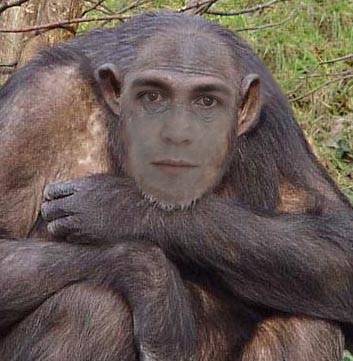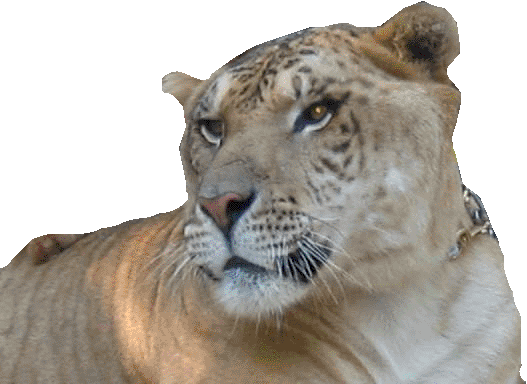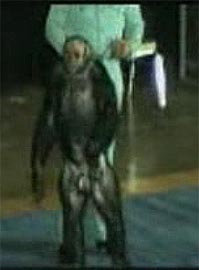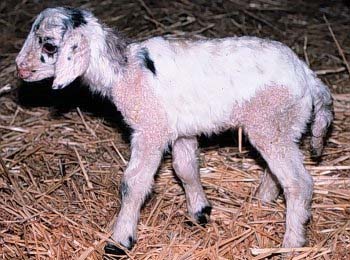pop up description layer
HOME
Cryptozoology UFO Mysteries Aviation Space & Time Dinosaurs Geology Archaeology Exploration 7 Wonders Surprising Science Troubled History Library Laboratory Attic Theater Store Index/Site Map Cyclorama
Search the Site: |
|
The Case of the Humanzee In his 2006 book NEXT, the late author Michael Crichton tells the story of a scientist who crosses his own genes with a chimpanzee to create a human/ape hybrid: A Humanzee. Is such a thing possible? Has it already been done? Man has been crossbreeding animals for longer than recorded history. Perhaps his greatest accomplishment is creating more than one-hundred and fifty breeds of dogs. In physical appearance dog breeds vary greatly from the tiny Chihuahua to the immense St. Bernard. Despite their differing sizes and shapes, however, all dogs are only one species: Canis lupus, the grey wolf. Over the centuries man has manipulated dogs by mating them in such a way as to give them shapes, sizes and temperaments that were useful, or at least pleasing to people. Hybrid Species While dog breeding takes place inside a single species, it is also possible to cross two closely related animals from different species. The resulting creature is known as a hybrid. Perhaps the most familiar of these animals is the mule. The mule is the result of crossing a male donkey with a female horse. This combination gives the hyrid some of the best characteristics of both parents: A mule is more patient than a horse, stronger than a donkey and more intelligent than either species. Mules, like all hybrids between species, are almost always infertile and cannot produce offspring. Donkeys have 62 chromosomes (the structures that carry the animal's DNA), while horses have 64. This mismatch causes the infertility. Because most mules cannot birth offspring, the mule population must be maintained by constantly breeding donkeys and horses together. Other hybrids between species exist, many created through the intervention of man. The liger is the hybrid of a male lion and a female tiger. (Breeding a male tiger with a female lion produces a tigon - the convention is to use the father's species name at the beginning of the hybrid name and the mother's at the end).
Since lions and tigers mostly exist on two different continents, these hybrids did not appear until man brought the animals together at zoos, animal parks or circuses. The resulting liger is much larger than either of the parent species and is considered the largest cat in the world. The combination of the two species chromosomes short-circuits the animal's natural mechanisms that limit size. Some examples of these animals weigh more than a thousand pounds and are over ten feet in length. If equines and the great cats can be crossbred over different species, how about man? Is it possible to create a human hybrid with some other species? Humanzee In order to create a hybrid between two species, the species must be closely related as are horses to donkeys or lions to tigers. The closest living animal to Homo sapiens is Pan troglodytes, the common chimpanzee. According to recent studies, 99.4% of the functional parts of human and chimpanzee DNA is exactly the same. This is so close that some scientists are suggesting that the common chimpanzee and another close relative, the bonobo, should be reclassified to be in the genus Homo along with humans, not Pongidae, with the rest of the great apes. While humans and chimps have very close DNA sequences, the DNA is arranged differently with humans having 46 chromosomes and chimps having 48. This is not necessarily a block to creating a hybrid, however. Horses have 64 chromosomes and donkeys 62 but can be crossed to create a mule. In fact, it is possible to cross a horse with a zebra where the gap is even larger. Scientists have also found evidence in our DNA that human ancestors and chimp ancestors interbred as recently as 1.2 million years ago. It may be possible that humans are actually the descendants of a hybrid of a chimp ancestor that crossed with another human line that has since died out. The idea that it might be possible to create a human/chimp hybrid - a humanzee or a chuman - raises many legal and ethical issues. Chimps are animals that can be owned as property. Humans, in most modern countries that have outlawed slavery, cannot be owned. Into what category would a humanzee fall? If we choose to recognize a humanzee as having the same rights as a human, would that change the status of chimps? Even if the legal status of a humanzee could be ironed out, most people accord a special status to human beings and might find the existence of such a creature unnatural and repellant.
Ivanov's Experiments Despite these quandaries, at least one scientist has tried to create such a creature. The controversial Russian biologist Ilya Ivanovich Ivanov was an early 20th century researcher that specialized in creating and studying hybrid creatures. Ivanov perfected the technique of using artificial insemination to create these hybrids and was well known at the beginning the century for his work in breeding horses. In 1910 he presented a paper to the World Congress of Zoologists in which he suggested the possibility of creating a human-ape hybrid through artificial insemination. Fourteen years later while working at Pasteur Institute in Paris, he got his chance. He obtained permission from the Institute's directors to use its primate research station in Kindia, French Guinea, as the laboratory for his experiments and got $10,000 from the Russian Academy of Sciences to pay for them. In March of 1926 Ivanov arrived at the station only to find it had no sexually-mature chimpanzees to work with. So in November 1926, he traveled to the botanical gardens in Conakry, French Guinea, and set up shop there. Several adult chimpanzees from the interior of the country were brought to Conakry and Ivanov artificially inseminated three female chimpanzees with human sperm. None became pregnant. Ivanov was also interested in trying to impregnate human females with chimp sperm, but officials in New Guinea balked at this idea. When he returned to Russian in 1927 he designed an experiment to try and impregnate 5 female volunteers, but was hampered by the lack of a male chimp to provide the sperm. In 1930 Ivanov fell out of favor with the government, was arrested and spent the rest of his life in exile in Kazakhstan where he died in 1932 without doing any additional ape/human hybrid studies. Ivanov's work is the only acknowledged attempt to create a Humanzee, but rumors of other experiments persist. There are stories that an attempt was made in the 1920's at the Yerkes National Primate Research Center in Orange Park, Florida. University of Albany psychologist Gordon Gallup relates a story that as a young graduate student he had talked to a member of the research team who had been at Yerkes. The elderly scientist told Gallup that the experiment had resulted in a live birth, but the research team had decided to destroy the creature after only a few days. Another story from the 1960's has a female chimp at a laboratory in China being successfully impregnated with human sperm, but dying before giving birth. The Case of Oliver
Perhaps the most well-known humanzee rumor is the case of "Oliver." In 1960 Oliver was one of several chimps imported from Africa to the United States for trainers Frank and Janet Berger. From early on the Bergers recognized that Oliver was different from other chimps they had trained. He had a flatter face and always walked in an upright position on two legs with his knees locked. The Bergers began to wonder if Oliver was some kind of human-chimp hybrid. Oliver didn't get along with other chimps and as he reached sexual maturity he showed a marked disregard for female chimps and an interest in human females. In the late seventies the Los Angeles Times did an article about Oliver suggesting he was a "missing link" or a new sub-species of chimp. This eventually led to Oliver taking a trip to Japan at the behest of Japanese TV and being genetically tested by scientists there. If Oliver was a true human/chimp hybrid he should have had 47 chromosomes, halfway between the 46 possessed by humans and the 48 characteristic of chimps. Most of Oliver's samples showed 48 chromosomes. What's more, the chromosomes showed "banding" typical of chimps. A few of the samples showed 47 chromosomes, but this was attributed to testing error. Oliver passed through a series of owners and was eventually bought in 1989 by The Buckshire Corporation, a Pennsylvania laboratory that leased animals for scientific testing. Oliver was never used for testing and was retired to an animal sanctuary called Primarily Primates in 1998. The director, interested in Oliver's genetic history, arranged for more testing which confirmed the earlier Japanese results: Oliver, despite his strange appearance and behavior, was 100 percent chimpanzee. Creating a Chimera Given the ease of doing the experiment, it is likely that creating a chimp/human hybrid has been tried unofficially in at least a few laboratories over the past century. Yet, no humanzee report has ever been confirmed. This might suggest that despite the similarity of our DNA to chimps, it is just not compatible enough to naturally produce a hybrid. As scientists better understand how DNA works, the reason for this seems to be slowly emerging. There appears to be at least nine pericentric inversions in chimp chromosomes compared to our own. An inversion is when a section of the chromosome gets reversed end to end. If the inversion doesn't involve the center of the chromosome where the arms are joined it is called a paracentric inversion and seems to have little medical effect on the individual involved. A pericentic inversion, however, does involve the section where the arms of the chromosome are joined and can cause medical problems. It also makes it less likely that the individual can produce a viable offspring when they mate with someone who does not have the inversion. The fact that nine of these inversions separate humans from chimps virtually eliminates the possibility of a viable offspring, especially given the few times such an attempt has probably been made. Scientists are now investigating pericentric inversions as one mechanism that might enforce the separation of species during the course of evolution. By better understanding why a natural humanzee birth is so unlikely, however, we also probably know how it could be achieved. If the chromosome inversions in a chimpanzee ovum could be reversed to match those in a human, a viable fetus might be created.
Currently cutting and splicing DNA is at the edge of our technical abilities. As we get better at this, however, chromosome alteration will become commonplace and widespread. Even now scientists are inserting genes and cells into animals to create what are called chimeras - a mixture of two or more species in one body. These are used mostly to conduct medical research. Scientists think that the more human-like an animal is, the better research model it becomes for testing drugs or growing "spare parts," such as livers, that could be transplanted into humans. For example, scientists have already created pigs that can produce human blood. While most of this work only creates animals that are a tiny percent human, the same techniques could be used to make a full chimp/human hybrid. Will someone in some far-flung laboratory attempt this experiment in the near future? Perhaps a better question is, should someone attempt this experiment? Partial Bibliography Chimps are Human, Gene Study Implies by.Jeff Hech. New Scientist,. http://www.newscientist.com/article/dn3744. Human Ancestors May Have Interbred With Chimpanzees, by David Brown. Washington Post, http://www.washingtonpost.com/wp-dyn/content/article/2006/05/17/AR2006051702158.html Chromosomal Inversions and the Reproductive Isolation of Species by Mohamed A. F. Noor , Katherine L. Grams, Lisa A. Bertucci, and Jane Reiland, Proceedings of the National Academy of Sciences Website http://www.pnas.org/content/98/21/12084.full Da Capo by Grady Towers, The Prometheus Society, http://www.prometheussociety.org/articles/DaCapo.html Copyright Lee Krystek 2009. All Rights Reserved.
|
|
Related Links |
|
|








